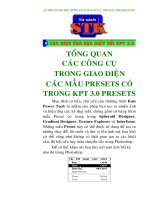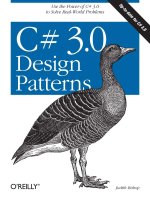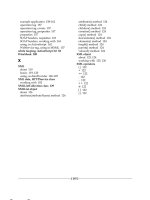Tài liệu C# 3.0 Design Patterns docx
Bạn đang xem bản rút gọn của tài liệu. Xem và tải ngay bản đầy đủ của tài liệu tại đây (3.55 MB, 316 trang )
C# 3.0 Design Patterns
Other Microsoft .NET resources from O’Reilly
Related titles
C# 3.0 in a Nutshell
C# 3.0 Cookbook
Head First C#
Head First Design Patterns
Learning C# 2005
Programming C# 3.0
.NET Books
Resource Center
dotnet.oreilly.com is a complete catalog of O’Reilly’s books on
.NET and related technologies, including sample chapters and
code examples.
ONDotnet.com provides independent coverage of fundamental,
interoperable, and emerging Microsoft .NET programming and
web services technologies.
Conferences
O’Reilly & Associates bring diverse innovators together to nur-
ture the ideas that spark revolutionary industries. We specialize
in documenting the latest tools and systems, translating the
innovator’s knowledge into useful skills for those in the
trenches. Visit conferences.oreilly.com for our upcoming events.
Safari Bookshelf (safari.oreilly.com) is the premier online refer-
ence library for programmers and IT professionals. Conduct
searches across more than 1,000 books. Subscribers can zero in
on answers to time-critical questions in a matter of seconds.
Read the books on your Bookshelf from cover to cover or sim-
ply flip to the page you need. Try it today for free.
C# 3.0 Design Patterns
Judith Bishop
Beijing
•
Cambridge
•
Farnham
•
Köln
•
Paris
•
Sebastopol
•
Taipei
•
Tokyo
C# 3.0 Design Patterns
by Judith Bishop
Copyright © 2008 Judith Bishop. All rights reserved.
Printed in the United States of America.
Published by O’Reilly Media, Inc., 1005 Gravenstein Highway North, Sebastopol, CA 95472.
O’Reilly books may be purchased for educational, business, or sales promotional use. Online editions
are also available for most titles (safari.oreilly.com). For more information, contact our
corporate/institutional sales department: (800) 998-9938 or
Editor:
John Osborn
Production Editor:
Loranah Dimant
Copyeditor:
Rachel Wheeler
Proofreader:
Loranah Dimant
Indexer:
John Bickelhaupt
Interior Designer:
David Futato
Cover Illustrator:
Karen Montgomery
Illustrator:
Jessamyn Read
Printing History:
December 2007: First Edition.
Nutshell Handbook, the Nutshell Handbook logo, and the O’Reilly logo are registered trademarks of
O’Reilly Media, Inc. C# 3.0 Design Patterns, the image of a greylag goose, and related trade dress are
trademarks of O’Reilly Media, Inc.
Many of the designations used by manufacturers and sellers to distinguish their products are claimed as
trademarks. Where those designations appear in this book, and O’Reilly Media, Inc. was aware of a
trademark claim, the designations have been printed in caps or initial caps.
While every precaution has been taken in the preparation of this book, the publisher and author assume
no responsibility for errors or omissions, or for damages resulting from the use of the information
contained herein.
This book uses RepKover
™
, a durable and flexible lay-flat binding.
ISBN 10: 0-596-52773-X
ISBN 13: 978-0-596-52773-0
[M]
In memory of my beloved father,
Tom Mullins (1920–2007).
vii
Table of Contents
Foreword
. . . . . . . . . . . . . . . . . . . . . . . . . . . . . . . . . . . . . . . . . . . . . . . . . . . . . . . . . . . . . . . .
xi
Preface
. . . . . . . . . . . . . . . . . . . . . . . . . . . . . . . . . . . . . . . . . . . . . . . . . . . . . . . . . . . . . . . .
xv
1. C# Meets Design Patterns
. . . . . . . . . . . . . . . . . . . . . . . . . . . . . . . . . . . . . . . . . . . .
1
About Patterns 2
About UML 3
About C# 3.0 5
About the Examples 6
2. Structural Patterns: Decorator, Proxy, and Bridge
. . . . . . . . . . . . . . . . . . . . . . .
8
Decorator Pattern 9
Proxy Pattern 22
Bridge Pattern 36
Example: OpenBook 39
Pattern Comparison 46
3. Structural Patterns: Composite and Flyweight
. . . . . . . . . . . . . . . . . . . . . . . . .
49
Composite Pattern 49
Flyweight Pattern 61
Exercises 72
Pattern Comparison 72
4. Structural Patterns: Adapter and Façade
. . . . . . . . . . . . . . . . . . . . . . . . . . . . . .
74
Adapter Pattern 74
Façade Pattern 93
Pattern Comparison 99
viii | Table of Contents
5. Creational Patterns: Prototype, Factory Method, and Singleton
. . . . . . . .
101
Prototype Pattern 101
Factory Method Pattern 110
Singleton Pattern 115
Pattern Comparison 120
6. Creational Patterns: Abstract Factory and Builder
. . . . . . . . . . . . . . . . . . . .
122
Abstract Factory Pattern 122
Builder Pattern 129
Pattern Comparison 137
7. Behavioral Patterns: Strategy, State, and Template Method
. . . . . . . . . . .
139
Strategy Pattern 139
State Pattern 148
Template Method Pattern 158
Pattern Comparison 162
8. Behavioral Patterns: Chain of Responsibility and Command
. . . . . . . . . . .
164
Chain of Responsibility Pattern 164
Command Pattern 175
Pattern Comparison 186
9. Behavioral Patterns: Iterator, Mediator, and Observer
. . . . . . . . . . . . . . . . .
188
Iterator Pattern 188
Mediator Pattern 200
Observer Pattern 210
Pattern Discussion and Comparison 217
10. Behavioral Patterns: Visitor, Interpreter, and Memento
. . . . . . . . . . . . . . .
220
Visitor Pattern 220
Interpreter Pattern 233
Memento Pattern 242
Pattern Comparison 252
Table of Contents | ix
11. The Future of Design Patterns
. . . . . . . . . . . . . . . . . . . . . . . . . . . . . . . . . . . . . .
253
Summary of Patterns 253
A Future for Design Patterns 256
Concluding Remarks 258
Appendix
. . . . . . . . . . . . . . . . . . . . . . . . . . . . . . . . . . . . . . . . . . . . . . . . . . . . . . . . . . . . . .
259
Bibliography
. . . . . . . . . . . . . . . . . . . . . . . . . . . . . . . . . . . . . . . . . . . . . . . . . . . . . . . . . . .
283
Index
. . . . . . . . . . . . . . . . . . . . . . . . . . . . . . . . . . . . . . . . . . . . . . . . . . . . . . . . . . . . . . . . .
285
xi
Foreword
1
When you’re faced with a problem to solve (and frankly, who isn’t these days?), the
basic strategy usually taken by we computer people is called “divide and conquer.” It
goes like this:
• Conceptualize the specific problem as a set of smaller sub-problems.
• Solve each smaller problem.
• Combine the results into a solution of the specific problem.
Reducing complex problems down to the level of twiddling the states of a few bil-
lion bits is what we do all day. But “divide and conquer” is not the only possible
strategy. We can also take a more generalist approach:
• Conceptualize the specific problem as a special case of a more general problem.
• Somehow solve the general problem.
• Adapt the solution of the general problem to the specific problem.
Design patterns are among the major tools in the toolboxes of those who espouse the
generalist approach. If you look at samples from a broad spectrum of software solu-
tions, you will find that though the specifics may vary widely, there is often an
underlying structural similarity. (Searching a filesystem for a file with a particular
attribute is in some sense structurally similar to searching an annotated parse tree for
a symbol with a particular type.) Design patterns codify general solutions to common
problems.
The ultimate example of the generalist approach is of course the design and imple-
mentation of programming languages themselves. As problem solving tools go, it is
hard to get more general than a programming language like C#. When designing
new programming languages (or new versions of old programming languages), we
think about common problems that are faced every day by real developers and figure
out how to create a language which solves them in a general, aesthetically pleasing,
and powerful way that is broadly applicable.
xii
|
Foreword
We want to embed the most useful and powerful abstractions so deeply into the lan-
guage infrastructure that you barely even consciously register them as being there
anymore. Patterns like “local variable” or “procedure call” or “while loop” are so
much a part of the air we all breathe that we don’t even think of them as patterns
anymore.
Furthermore, we want to make a language in which patterns which are useful but per-
haps not quite so fundamental are nevertheless relatively straightforward to implement
clearly and elegantly. A class in C# may be marked as “static,” or “abstract,” or
“sealed,” but not as “singleton.” That was a deliberate choice of the language design-
ers. However, implementing a singleton class in C# is still relatively easy.
The gray zone in between “clearly foundational” and “occasionally useful” is where
the interesting design challenges lie. Our observations of design patterns used by
real-world developers in C# (and other languages) strongly drive the design process
for new versions.
Consider for example how you would implement an iterator pattern on a linked list
in C# 1.0. You would end up defining an enumerator class to represent a position in
the list containing a lot of boring boilerplate code (which impedes readability), and
the solution would not be very reusable. The notion of “enumerate a set of things” is
sufficiently applicable to a wide variety of problems that it met the bar for inclusion
as a first class language concept. In C# 2.0 with its
yield return
statement the com-
piler can generate all the boring code for you, and the generic type system makes iter-
ating over a set of things typesafe no matter what the “things” are.
All of this is a long way to say just why it is that I am so very excited about Language
Integrated Query (LINQ) in C# 3.0. We believed that iterating over collections of
things was a great start, but that we could do so much more. Sorting, filtering, group-
ing, joining, projecting, and transforming data are also fundamental operations that
are useful in pretty much every domain. Whether you are writing a ray tracer, a com-
piler, an XML reader, or an online banking security system, odds are good that you
are going to need to manipulate collections of something in a rich way.
By moving these concepts out of domain-specific object models and into a general-
purpose programming language, we hopefully solve those more general problems.
We additionally hope, though, that by adding C# 3.0’s query expressions, lambda
expressions, extension methods, initializer expressions, expression trees, and so on
to the already rich set of C# 2.0 and 1.0 features, we make it easier to elegantly
implement all sorts of other useful design patterns.
Foreword
|
xiii
And that is also why I am excited about this book. C# 3.0 Design Patterns brings the
frequently abstruse world of design patterns into sharp focus with pragmatic C# 3.0
implementations. I look forward to seeing where developers can go with these tools
and this language, and what useful patterns we can build into the infrastructures of
future languages.
—Eric Lippert
Senior Developer
C# Compiler Team
Seattle, Washington
November 30, 2007









